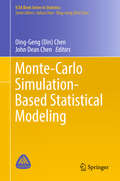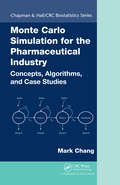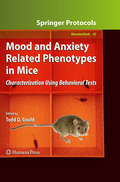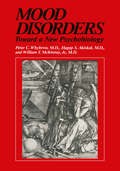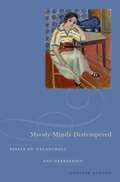- Table View
- List View
Monte Carlo in Heavy Charged Particle Therapy: New Challenges in Ion Therapy (Series in Medical Physics and Biomedical Engineering)
by Pablo Cirrone Giada PetringaThis book explores the current difficulties and unsolved problems in the field of particle therapy and, after analysing them, discusses how (and if) innovative Monte Carlo approaches can be used to solve them. Each book chapter is dedicated to a different sub-discipline, including multi-ion treatments, flash-radiotherapy, laser-accelerated beams, nanoparticles effects, binary reactions to enhance radiobiology, and space-related issues. This is the first book able to provide a comprehensive insight into this exciting field and the growing use of Monte Carlo in medical physics. It will be of interest to graduate students in medicine and medical physics, in addition to researchers and clinical staff. Key Features: Explores the exciting and interdisciplinary topic of Monte Carlo in particle therapy and medicine. Addresses common challenges in the field. Edited by an authority on the subject, with chapter contributions from specialists. Pablo Cirrone is a medical physicist and researcher at the Laboratori Nazionali del Sud of INFN, Italy, where he supports and coordinates various experimental groups. Dr. Cirrone is an expert in the use of proton and ion in radiation treatment and of absolute and relative dosimetry in electron, photon and ion beam. He is an expert in the development and test of detectors for medical applications, of the production and use of laser-driven beams for medical and multidisciplinary applications and recipient of the Michael Gotein Award. He is active on many scientific committees and organizes national and international conferences. Giada Petringa is a researcher at the Laboratori Nazionali del Sud of INFN, Italy. Dr. Petringa has a professional experience in the field of Monte Carlo simulations for medical applications, dosimetry, microdosimetry, and diagnostics with conventional and laser-driven proton beams. In 2019 she had a MSCA-IF-2019 (Marie Sklodowska-Curie Actions-Individual Fellowship) grant funded by the European Community in the framework of the H2020 program. She is a member of the Editorial Board of the international journal Physica Medica - European Journal of Medical. She organized more than fifteen international Geant4 Schools. She is an official member of the Geant4 code Collaboration at CERN since 2019. She is a code developer, and she collaborates to maintain two of the official examples of the code.
Monte Carlo in Heavy Charged Particle Therapy: New Challenges in Ion Therapy (Series in Medical Physics and Biomedical Engineering)
This book explores the current difficulties and unsolved problems in the field of particle therapy and, after analysing them, discusses how (and if) innovative Monte Carlo approaches can be used to solve them. Each book chapter is dedicated to a different sub-discipline, including multi-ion treatments, flash-radiotherapy, laser-accelerated beams, nanoparticles effects, binary reactions to enhance radiobiology, and space-related issues. This is the first book able to provide a comprehensive insight into this exciting field and the growing use of Monte Carlo in medical physics. It will be of interest to graduate students in medicine and medical physics, in addition to researchers and clinical staff. Key Features: Explores the exciting and interdisciplinary topic of Monte Carlo in particle therapy and medicine. Addresses common challenges in the field. Edited by an authority on the subject, with chapter contributions from specialists. Pablo Cirrone is a medical physicist and researcher at the Laboratori Nazionali del Sud of INFN, Italy, where he supports and coordinates various experimental groups. Dr. Cirrone is an expert in the use of proton and ion in radiation treatment and of absolute and relative dosimetry in electron, photon and ion beam. He is an expert in the development and test of detectors for medical applications, of the production and use of laser-driven beams for medical and multidisciplinary applications and recipient of the Michael Gotein Award. He is active on many scientific committees and organizes national and international conferences. Giada Petringa is a researcher at the Laboratori Nazionali del Sud of INFN, Italy. Dr. Petringa has a professional experience in the field of Monte Carlo simulations for medical applications, dosimetry, microdosimetry, and diagnostics with conventional and laser-driven proton beams. In 2019 she had a MSCA-IF-2019 (Marie Sklodowska-Curie Actions-Individual Fellowship) grant funded by the European Community in the framework of the H2020 program. She is a member of the Editorial Board of the international journal Physica Medica - European Journal of Medical. She organized more than fifteen international Geant4 Schools. She is an official member of the Geant4 code Collaboration at CERN since 2019. She is a code developer, and she collaborates to maintain two of the official examples of the code.
Monte Carlo Methods for Radiation Transport: Fundamentals and Advanced Topics (Biological and Medical Physics, Biomedical Engineering)
by Oleg N. VassilievThis book is a guide to the use of Monte Carlo techniques in radiation transport. This topic is of great interest for medical physicists. Praised as a "gold standard" for accurate radiotherapy dose calculations, Monte Carlo has stimulated a high level of research activity that has produced thousands of papers within the past few years. The book is designed primarily to address the needs of an academically inclined medical physicist who wishes to learn the technique, as well as experienced users of standard Monte Carlo codes who wish to gain insight into the underlying mathematics of Monte Carlo algorithms. The book focuses on the fundamentals—giving full attention to and explaining the very basic concepts. It also includes advanced topics and covers recent advances such as transport of charged particles in magnetic fields and the grid-based solvers of the Boltzmann equation.
Monte Carlo Methods in Bayesian Computation (Springer Series in Statistics)
by Ming-Hui Chen Qi-Man Shao Joseph G. IbrahimDealing with methods for sampling from posterior distributions and how to compute posterior quantities of interest using Markov chain Monte Carlo (MCMC) samples, this book addresses such topics as improving simulation accuracy, marginal posterior density estimation, estimation of normalizing constants, constrained parameter problems, highest posterior density interval calculations, computation of posterior modes, and posterior computations for proportional hazards models and Dirichlet process models. The authors also discuss model comparisons, including both nested and non-nested models, marginal likelihood methods, ratios of normalizing constants, Bayes factors, the Savage-Dickey density ratio, Stochastic Search Variable Selection, Bayesian Model Averaging, the reverse jump algorithm, and model adequacy using predictive and latent residual approaches. The book presents an equal mixture of theory and applications involving real data, and is intended as a graduate textbook or a reference book for a one-semester course at the advanced masters or Ph.D. level. It will also serve as a useful reference for applied or theoretical researchers as well as practitioners.
Monte-Carlo Simulation-Based Statistical Modeling (ICSA Book Series in Statistics)
by Ding-Geng Din Chen John Dean ChenThis book brings together expert researchers engaged in Monte-Carlo simulation-based statistical modeling, offering them a forum to present and discuss recent issues in methodological development as well as public health applications. It is divided into three parts, with the first providing an overview of Monte-Carlo techniques, the second focusing on missing data Monte-Carlo methods, and the third addressing Bayesian and general statistical modeling using Monte-Carlo simulations. The data and computer programs used here will also be made publicly available, allowing readers to replicate the model development and data analysis presented in each chapter, and to readily apply them in their own research. Featuring highly topical content, the book has the potential to impact model development and data analyses across a wide spectrum of fields, and to spark further research in this direction.
Monte Carlo Simulation for the Pharmaceutical Industry: Concepts, Algorithms, and Case Studies
by Mark ChangHelping you become a creative, logical thinker and skillful "simulator," Monte Carlo Simulation for the Pharmaceutical Industry: Concepts, Algorithms, and Case Studies provides broad coverage of the entire drug development process, from drug discovery to preclinical and clinical trial aspects to commercialization. It presents the theories and metho
Monte Carlo Techniques in Radiation Therapy: Applications to Dosimetry, Imaging, and Preclinical Radiotherapy (Imaging in Medical Diagnosis and Therapy)
by Joao SecoThoroughly updated throughout, this second edition of Monte Carlo Techniques in Radiation Therapy: Applications to Dosimetry, Imaging, and Preclinical Radiotherapy, edited by Joao Seco and Frank Verhaegen, explores the use of Monte Carlo methods for modelling various features of internal and external radiation sources. Monte Carlo methods have been heavily used in the field of radiation therapy in applications such as dosimetry, imaging, radiation chemistry, modelling of small animal irradiation units, etc. The aim of this book is to provide a compendium of the Monte Carlo methods that are commonly used in radiation therapy applications, which will allow students, postdoctoral fellows, and university professors to learn and teach Monte Carlo techniques. This book provides concise but detailed information about many Monte Carlo applications that cannot be found in any other didactic or scientific book. This second edition contains many new chapters on topics such as: Monte Carlo studies of prompt gamma emission Developments in proton imaging Monte Carlo for cone beam CT imaging Monte Carlo modelling of proton beams for small animal irradiation Monte Carlo studies of microbeam radiation therapy Monte Carlo in micro- and nano-dosimetry GPU-based fast Monte Carlo simulations for radiotherapy This book is primarily aimed at students and scientists wishing to learn and improve their knowledge of Monte Carlo methods in radiation therapy.
Monte Carlo Techniques in Radiation Therapy: Introduction, Source Modelling and Patient Dose Calculations (Imaging in Medical Diagnosis and Therapy)
by Frank VerhaegenAbout ten years after the first edition comes this second edition of Monte Carlo Techniques in Radiation Therapy: Introduction, Source Modelling and Patient Dose Calculations, thoroughly updated and extended with the latest topics, edited by Frank Verhaegen and Joao Seco. The book aims to provide a brief introduction to the history and basics of Monte Carlo simulation, but again has a strong focus on applications in radiotherapy. Since the first edition, Monte Carlo simulation has found many new applications, which were included in detail. The applications sections in this book cover: Modelling transport of photons, electrons, protons and ions Modelling radiation sources for external beam radiotherapy Modelling radiation sources for brachytherapy Design of radiation sources Modelling dynamic beam delivery Patient dose calculations in external beam radiotherapy Patient dose calculations in brachytherapy Use of Artificial Intelligence in Monte Carlo simulations This book is intended for both students or professionals, both novice and experienced, in medical radiotherapy physics. The book combines overviews of development, methods and references to facilitate Monte Carlo studies.
Monte Carlo Techniques in Radiation Therapy: Introduction, Source Modelling and Patient Dose Calculations (Imaging in Medical Diagnosis and Therapy)
by Frank Verhaegen Joao SecoAbout ten years after the first edition comes this second edition of Monte Carlo Techniques in Radiation Therapy: Introduction, Source Modelling and Patient Dose Calculations, thoroughly updated and extended with the latest topics, edited by Frank Verhaegen and Joao Seco. The book aims to provide a brief introduction to the history and basics of Monte Carlo simulation, but again has a strong focus on applications in radiotherapy. Since the first edition, Monte Carlo simulation has found many new applications, which were included in detail. The applications sections in this book cover: Modelling transport of photons, electrons, protons and ions Modelling radiation sources for external beam radiotherapy Modelling radiation sources for brachytherapy Design of radiation sources Modelling dynamic beam delivery Patient dose calculations in external beam radiotherapy Patient dose calculations in brachytherapy Use of Artificial Intelligence in Monte Carlo simulations This book is intended for both students or professionals, both novice and experienced, in medical radiotherapy physics. The book combines overviews of development, methods and references to facilitate Monte Carlo studies.
Monte Carlo Techniques in Radiation Therapy: Applications to Dosimetry, Imaging, and Preclinical Radiotherapy (Imaging in Medical Diagnosis and Therapy)
by Frank Verhaegen Joao SecoThoroughly updated throughout, this second edition of Monte Carlo Techniques in Radiation Therapy: Applications to Dosimetry, Imaging, and Preclinical Radiotherapy, edited by Joao Seco and Frank Verhaegen, explores the use of Monte Carlo methods for modelling various features of internal and external radiation sources. Monte Carlo methods have been heavily used in the field of radiation therapy in applications such as dosimetry, imaging, radiation chemistry, modelling of small animal irradiation units, etc. The aim of this book is to provide a compendium of the Monte Carlo methods that are commonly used in radiation therapy applications, which will allow students, postdoctoral fellows, and university professors to learn and teach Monte Carlo techniques. This book provides concise but detailed information about many Monte Carlo applications that cannot be found in any other didactic or scientific book. This second edition contains many new chapters on topics such as: Monte Carlo studies of prompt gamma emission Developments in proton imaging Monte Carlo for cone beam CT imaging Monte Carlo modelling of proton beams for small animal irradiation Monte Carlo studies of microbeam radiation therapy Monte Carlo in micro- and nano-dosimetry GPU-based fast Monte Carlo simulations for radiotherapy This book is primarily aimed at students and scientists wishing to learn and improve their knowledge of Monte Carlo methods in radiation therapy.
A Month To Marry The Midwife: Resisting Her Army Doc Rival / A Month To Marry The Midwife (The Midwives of Lighthouse Bay #1)
by Fiona McArthurFalling for the midwife
Mood and Anxiety Related Phenotypes in Mice: Characterization Using Behavioral Tests (Neuromethods #42)
by Todd D. GouldAffecting approximately twenty percent of the world population, mood and anxiety disorders have been the subject of ever-increasing research. This increased research parallels a remarkable growth in the use of the laboratory mouse as a tool to understand the biological and genetic basis of mood and anxiety disorders as well as to develop improved treatments. In Mood and Anxiety Related Phenotypes in Mice: Characterization Using Behavioral Tests, world-renowned researchers provide an overview of behavioral approaches utilized in the characterization of mood and anxiety related behaviors in mice as well as commonly used behavioral assays to assess the potential antidepressant and anxiolytic efficacy of novel compounds. As a volume in the successful Neuromethods™ series, the chapters provide authoritative reviews including up-to-date detailed protocols of the most commonly used approaches in the field. Mood and Anxiety Related Phenotypes in Mice: Characterization Using Behavioral Tests is an ideal resource for scientists actively pursuing or interested in establishing behavioral protocols in their laboratories, while also serving as a reference for those students, scientists, and practitioners who have an interest in better understanding the preclinical behavioral methods used in mood and anxiety research.
Mood and Anxiety Related Phenotypes in Mice: Characterization Using Behavioral Tests, Volume II (Neuromethods #63)
by Todd D. GouldPreclinical research related to mood and anxiety disorders relies extensively upon mouse behavioral tests and models, the use of which continues to increase as a greater number of underlying susceptibility genes are discovered, new targets for medications are identified, and clinical studies reveal novel neurobiological risk factors. Mood and Anxiety Related Phenotypes in Mice: Characterization Using Behavioral Tests, Volume II serves as a complement to the previous volume in order to offer a comprehensive resource for the behavioral approaches that are valuable for the characterization of mood and anxiety disorder-related behaviors in mice and the techniques that are utilized in the development of effective medications. As a collection presented in the Neuromethods series, each chapter provides a brief background and review of the test or model as well as a complete and up-to-date protocol narrative. Authoritative and comprehensive, Mood and Anxiety Related Phenotypes in Mice: Characterization Using Behavioral Tests, Volume II is an ideal resource for scientists actively pursuing or interested in establishing vital behavioral protocols in their laboratories.
Mood Disorders: Clinical Management and Research Issues
by Eric J. L. GriezWritten by an outstanding team of internationally recognised experts, this practical textbook is based on the European Certificate in Anxiety and Mood Disorders. It provides a thorough overview of diagnosis and treatment of mood disorders and analyses the most recent developments and scientific evidence. Covers the most important clinical topics in the field, including symptomatology, natural course and diagnosis Treatment strategies are reviewed in the light of all available empirical evidence Outstanding list of international contributors
Mood Disorders: Practical Issues in Diagnosis and Management
by Ather MuneerMood Disorders: Practical Issues in Diagnosis and Management provides cutting edge knowledge about the diagnosis and treatment of principal mood disorders, namely major depressive disorder and bipolar disorder. Covering diagnosis, differentiating features, and illness course and trajectories of principal mood disorders, Dr. Ather Muneer provides essential information in a succinct and practical manner, while highlighting significant new findings in the area. This book will help a broad range of mental health professionals better treat the millions of people with mood disorders across the globe.
Mood Disorders: Practical Issues in Diagnosis and Management
by Ather MuneerMood Disorders: Practical Issues in Diagnosis and Management provides cutting edge knowledge about the diagnosis and treatment of principal mood disorders, namely major depressive disorder and bipolar disorder. Covering diagnosis, differentiating features, and illness course and trajectories of principal mood disorders, Dr. Ather Muneer provides essential information in a succinct and practical manner, while highlighting significant new findings in the area. This book will help a broad range of mental health professionals better treat the millions of people with mood disorders across the globe.
Mood Disorders: Toward a New Psychobiology (Critical Issues in Psychiatry)
by Peter C. Whybrow Hagop S. Akiskal William T. McKinney Jr.In this book we present a conceptually integrated approach to disorders of mood. These disorders are defined narrowly as the clinical syndromes of mania and melancholia. The latter is our particular focus, for the simple reason that it is more common and thus more is known about it. Our approach owes much to Adolf Meyer, who first used the term psychobiology. It was he who emphasized in a practical way the importance of the clinician consider ing the joint contribution of psychosocial and biological factors in the genesis of mental disorders. However, until the 1960s, our relative ignorance of basic mechanisms that link brain and behavior prevented the development of a genuine psychobiological perspective. Thus Meyer's work was concerned largely with teaching the importance of the personal biography and a consideration of social history in the development of mental disorder. We feel that sufficiently rigorous data have now emerged in psychia try to permit tentative but real psychobiological integration. Affective illness is proba bly the most promising area for an attempt at such a synthesis. It is our belief that the theory and clinical practice of psychiatry now can be woven into a coherent theme, integrating insights and evidence generated by the psychodynamic, biological, and behavioral methods; hence in part we review the emerging psychobiology of mood disorders with the hope that it can serve as a generic paradigm for other psychiatric syndromes.
Mood Dysregulation: Beyond the Bipolar Spectrum
by Deborah A. DeliyannidesReflecting the author’s vast clinical experience as a psychiatrist, this volume explains why so many people with treatment resistant depression respond to medication used to treat individuals with bipolar disorder. The book also helps to minimize the bipolar stigma by introducing the concept of "mood dysregulation." At present, people with mood dysregulation are not adequately described on the pages of any diagnostic manual. A cardinal feature of mood dysregulation is dysphoria, a negative mood that is poorly understood but mistaken for the negative mood of depression, creating diagnostic confusion, one of the sources of treatment resistant depression. The author explains that a preponderance of the people she has seen in her practice who have so-called depression have mood disorders with features of bipolar disorder, including response to medications typically effective in people with bipolar disorders. Thus, these people are research orphans: to this day, a paucity of literature exists on this group of individuals. In this volume, the author addresses the clinical problems that result from failure to recognize such mood disorders. Key features of the book: Provides a thorough discussion of dysphoria that is not found in other books on the market Proposes a solution to a common and troublesome clinical problem, that of misidentified treatment resistant depression Helps to destigmatize the treatments that are most beneficial to those with dysphoria by introducing the concept of "mood dysregulation" Discusses the etiology of mood disorders with implications for prevention This volume aims to help mental health professionals and patients more accurately recognize negative mood symptoms, dysphoria in particular, and arrive at more appropriate interventions to improve treatment outcomes for depression. No other book on the market takes up the topic of dysphoria and how its confusion with depression can lead to diagnostic mistakes that, in turn, lead to treatment failures and so-called treatment resistant depression.
Mood Dysregulation: Beyond the Bipolar Spectrum
by Deborah A. DeliyannidesReflecting the author’s vast clinical experience as a psychiatrist, this volume explains why so many people with treatment resistant depression respond to medication used to treat individuals with bipolar disorder. The book also helps to minimize the bipolar stigma by introducing the concept of "mood dysregulation." At present, people with mood dysregulation are not adequately described on the pages of any diagnostic manual. A cardinal feature of mood dysregulation is dysphoria, a negative mood that is poorly understood but mistaken for the negative mood of depression, creating diagnostic confusion, one of the sources of treatment resistant depression. The author explains that a preponderance of the people she has seen in her practice who have so-called depression have mood disorders with features of bipolar disorder, including response to medications typically effective in people with bipolar disorders. Thus, these people are research orphans: to this day, a paucity of literature exists on this group of individuals. In this volume, the author addresses the clinical problems that result from failure to recognize such mood disorders. Key features of the book: Provides a thorough discussion of dysphoria that is not found in other books on the market Proposes a solution to a common and troublesome clinical problem, that of misidentified treatment resistant depression Helps to destigmatize the treatments that are most beneficial to those with dysphoria by introducing the concept of "mood dysregulation" Discusses the etiology of mood disorders with implications for prevention This volume aims to help mental health professionals and patients more accurately recognize negative mood symptoms, dysphoria in particular, and arrive at more appropriate interventions to improve treatment outcomes for depression. No other book on the market takes up the topic of dysphoria and how its confusion with depression can lead to diagnostic mistakes that, in turn, lead to treatment failures and so-called treatment resistant depression.
Moodiness in ADHD: A Clinician's Guide
by W. Burleson DavissThis book gives clinicians a framework and tools to accurately assess moodiness in patients with ADHD, and to provide the most appropriate pharmacological and psychosocial treatments for such problems. This book reviews the assessment and treatment of moodiness in ADHD patients of all ages, but focuses primarily on children and adolescents. Chapters review effective assessment strategies for various potential causes of moodiness in patients with ADHD, then psychosocial and pharmacological treatments and their empirical basis. Specific chapters are devoted to the moodiness characteristic of ADHD itself, and to other disorders co-occurring with it such as disorders of mood, anxiety, trauma-exposure, disruptive behaviors, autism, substance use, and medical problems. The also text includes useful case summaries and tables to illustrate key clinical points useful in working with these patients. Moodiness in ADHD is a potentially vital resource for clinicians wanting to improve their skill working with patients having these challenging problems.
Moody Minds Distempered: Essays on Melancholy and Depression
by Jennifer RaddenIn Moody Minds Distempered philosopher Jennifer Radden assembles several decades of her research on melancholy and depression. The chapters are ordered into three categories: those about intellectual and medical history of melancholy and depression; those that emphasize aspects of the moral, psychological and medical features of these concepts; and finally, those that explore the sad and apprehensive mood states long associated with melancholy and depressive subjectivity. A newly written introduction maps the conceptual landscape, and draws out the analytic and thematic interconnections between the chapters. Radden emphasizes and develops several new themes: the implications, theoretical phenomenological and moral, of recognizing melancholy and depressive states as mood states; questions of method, as they affect how we understand and characterize claims about melancholy and depression; and the persistence and force of cultural tropes linking such states to brilliance, creativity, and sagacity. Insights from literature and the history of medicine, psychology, and psychiatry are woven together with those from the more recent disciplines of feminist theory and cultural studies. This is interdisciplinary writing at its best-part analytic philosophy, and part history of ideas.
Moonlight Road: Forbidden Falls Angel's Peak Moonlight Road Midnight Confessions (A Virgin River Novel #10)
by Robyn CarrVirgin River – now a Netflix Original series Moonlight Road – Virgin River Book 10 Appearances can be deceiving
Moonlighting Cell Stress Proteins in Microbial Infections (Heat Shock Proteins #7)
by Brian HendersonMicrobial infection is increasingly seen as a problem as we begin to run out of antibiotics. Understanding how microbes cause disease is essential. In recent years it has begun to emerge that bacteria, fungi, protozoa and viruses can use their cell stress proteins to cause infection. This volume brings together the world's leading experts in the study of the microbial and human cell stress proteins that are involved in enabling microorganisms to infect humans and cause serious disease.
Moonshot: Inside Pfizer's Nine-month Race To Make The Impossible Possible
by Albert BourlaThe exclusive, first-hand, behind-the-scenes story of how Pfizer raced to create the first Covid-19 vaccine, told by Pfizer’s CEO Dr. Albert Bourla




